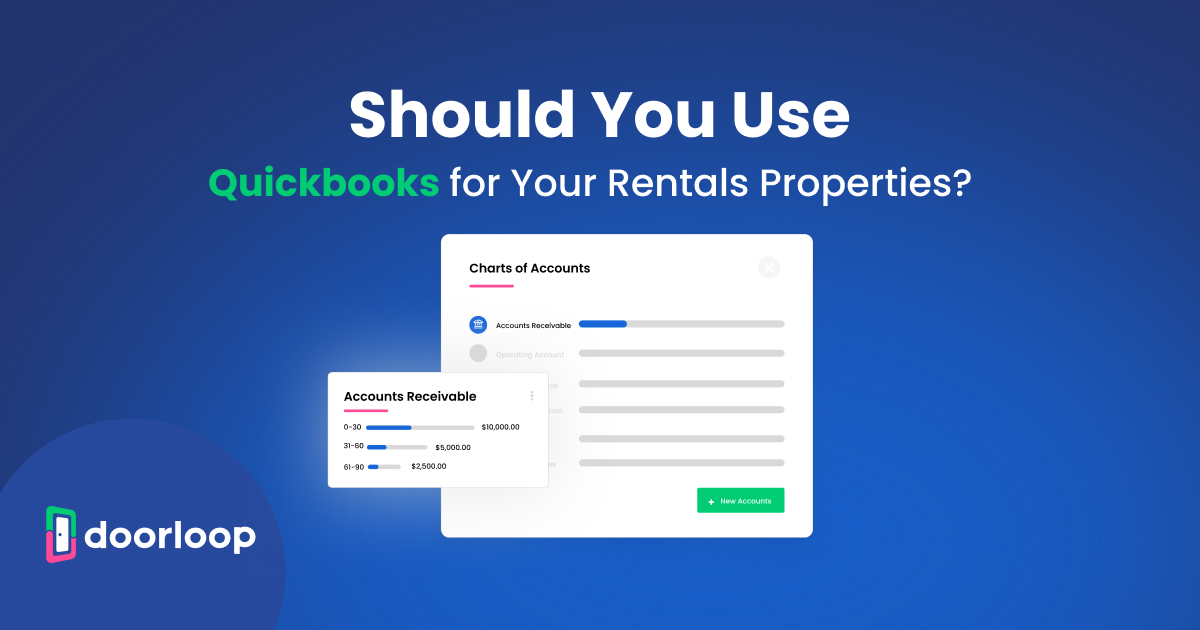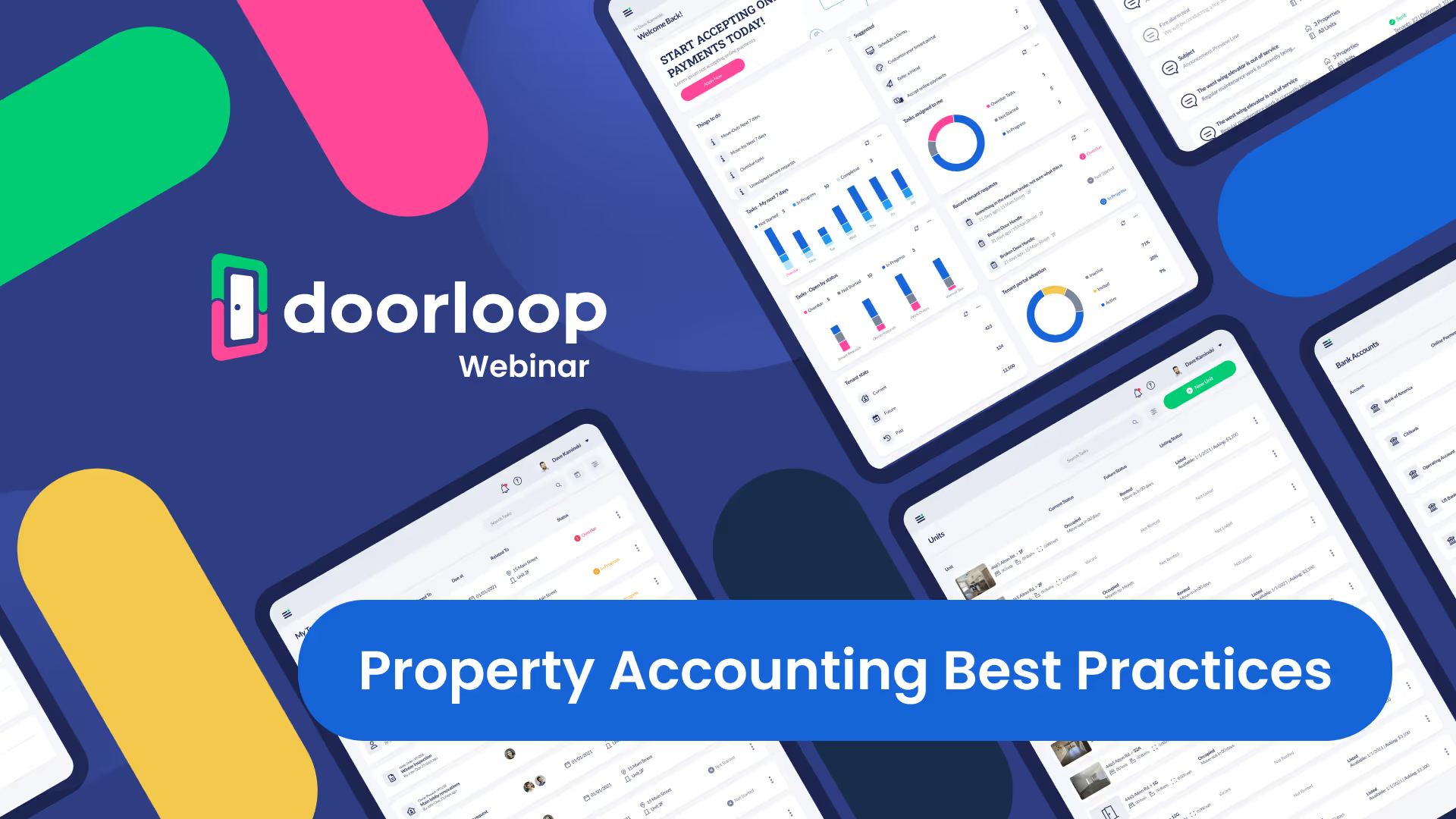The ins and outs of managing a rental property give a real estate investor plenty to think about. The common denominator between almost every item on the list is to maximize profitability and increase cash flow through an investment property.
Making money is the aim of the game, and keeping track of how much cash flow you have can feel a little complicated.
Analyzing rental property cash flow helps a real estate investor understand the financial performance of an investment to date, stay on top of their rental income, and make decisions about the future. Knowing how to calculate net cash flow and apply it to important investment indicators makes a big difference.
In this guide, we cover the must-knows about calculating cash flow for a rental property, what figures you need, the formulas you will use, and how you can utilize the numbers to analyze investment returns.
DoorLoop also provides a free rental property cash flow analysis and countless other valuable tools to help you manage your real estate investments and the money they generate.
What Is Cash Flow?
What are we talking about when we say cash flow?
You will come across a few terms and phrases used in the real estate business to describe earnings, and it is important to understand what means what.
In real estate, cash flow is the general name for how money moves through a property, beginning with income and ending with your net income before tax.
A cash flow analysis tracks the entire journey from the initial money coming in initially, through the expenses and deductions, to the finable taxable amount. You can then use that figure to calculate your after-tax earnings.
Positive Cash Flow and Negative Cash Flow: What Do They Mean for Your Property?
Your real estate investment will either be cash flow positive or cash flow negative.
A good cash flow positive property has more cash coming in than going out, while a negative cash flow shows that the expenses and costs outweigh the income.
The goal, of course, is to have an average cash flow that is positive- a.k.a. profitable- rather than lose money overall.
There are, however, times when you may expect to have a cash flow negative property- during renovations or in extended vacancy periods, for example. In these cases, you can use a cash flow analysis to monitor how much you are losing and what it means for your return on investment.
How Does Cash Flow Work in Rental Property Investing?
Before we look at the calculations and variables involved in a cash flow analysis, let's get a better overview of what a rental property cash flow looks like.
It begins with all income generated through the property- usually through monthly rent, in this case, but it can include other things (more on that later). That income is then filtered through the property, with deductions for expenses and other fees along the way.
What comes back to you at the other end is your net cash flow before tax.
Picture it like this.
You scoop up a bucket of seawater (your gross cash flow). First, you pour it through a sieve that catches the sand (your operating expenses), separating the water. Next, the water is filtered to remove the salt (the debt service). You are left with the clean water at the end (your pre-tax net cash flow).
How Can Rental Property Investors Calculate Cash Flow?
The cash flow calculation formula is very simple and looks like this.
- Gross Income - Gross Operating Expenses - Debt Service = Net Cash Flow
It really is that simple. Where the work comes in is calculating the right amounts for the variables. Here is a closer look at each one before we go through the steps of a cash flow analysis in detail.
Total Rental Income
You can calculate gross cash flow monthly or annually but annually is the more common metric.
Monthly rental income is the primary source of earnings in this type of real estate investing business, so it makes up an important part of your analysis.
Work out the gross rental income for the year- and don't forget to account for discounts and vacancies.
Additional Income
Rental property income doesn't always come solely from the monthly rent. If you earn in any other way through the unit, include that as well.
Commercial units with parking facilities or advertising spots should include these two. Any earnings you gain from your property investment make up your gross cash flow.
Operating Expenses
Operating expenses are the general costs of keeping your investment property up and running.
These include maintenance fees, property management costs, and insurance, but not taxes or mortgage payments.
All these expenses must be deducted from the gross annual cash flow so you know how much you have left over.
Debt Services
Lastly, you need to account for any debts you are repaying on the investment. In real estate (for most investors), that means the monthly mortgage payment.
This is separate from the operating expenses in a cash flow calculation but must be added to give you a better idea of your actual leftover profit.
Analyzing Cash Flow for Rental Properties
Okay, now let's look at the key stages in a cash flow analysis and the calculations that go along with each. We have also included some examples to help you picture what it all looks like in action.
Total Your Gross Cash Flow
The first piece of the puzzle is calculating the total income generated through your investment property- a.k.a. your gross cash flow.
To find this number, you should start by working out how much you earn in rental income. If you have a set monthly rent of $2000 and a long-term lease, you can work this out by multiplying the monthly rental income by 12.
- $3000 x 12 = $36,000 Gross Annual Rent
Depending on your situation, you may need to adjust the actual annual gross rental income amount. You need to account for vacancy rates, free rent months, and any discounts offered.
Let's say you have a long-term renter, but they didn't move in until February. Until then, the unit was empty. You offered pro-rated rent since they moved in on the 14th, so you only received rent for half of that month.
Based on this example, you would have 1.5 vacant months or a vacancy rate of 12.5%. You can do the calculation by adding each month's amount individually or by subtracting 12.5% from the gross possible rent amount. Using the same numbers as above, the calculation would look like this.
- $36,000 - 12.5% Vacancy Rate = $31,500 Actual Annual Rent
You should also add any other income related to the property, including pet licenses and parking fees, advertising, or any other property-specific earnings. Add that total to the total rental income to find the gross annual income.
Work Out Your Gross Operating Expenses
Next, calculate how much you spend on your property to keep the operation running smoothly. Anything that costs you money because you own the property should be considered operating expenses.
Rental property expenses include utility costs, maintenance, property management and leasing fees, insurance payments, and real estate taxes (not income taxes). If you have capital expenditures (CapEx) reserve contributions, these should also be included.
A typical list of operational expenses may look like this (rough numbers used for simplicity).
- Maintenance costs $500
- Insurance $1,000
- Property taxes $800
- Leasing fees $200
- Utilities $1,000
- Property management fees $500
This would make the total operating expenses for the year $4,000.
Calculate Net Operating Income (Without Mortgage Payments or Other Financing)
To find your net operating income (which is calculated without financing), you use this simple formula.
- Gross Income - Gross Operating Expenses = Net Operating Income (NOI)
Let's take the previous examples to show what this would look like.
Our annual income after applying the vacancy rates was $31,500, and the operating expenses came to $4,000.
- $31,500 - $4,000 = NOI $27,500
Calculate Net Operating Income with Relevant Debt Service
The last step in working out the cash flow on your rental property is to deduct the debt services- meaning any money you spend as part of a financing arrangement for the investment.
More often than not, for real estate investors, that means the mortgage. Once you have worked out your NOI before financing, you should deduct the monthly mortgage payment to get the final net operating income.
Let's imagine the mortgage payment for this rental property is $1,250 per month. That means this real estate investor pays $15,000 each year toward their mortgage.
- $27,500 - $15,000 annual mortgage payment total = $12,500 NOI
Since net operating income calculations in real estate do not include income tax, this is the final figure for NOI to be used in some important calculations.
That said, if you want to calculate what you walk away with, you need to account for income tax after you finish this central cash flow analysis.
Calculating Taxable Cash Flow
Most real estate investors want to analyze their cash flow as accurately as possible. That means factoring in income taxes.
Almost every landlord and rental property investor must pay tax on their rental income since it is viewed like any other income (taxable) in the eyes of state and federal laws. Your net cash flow or income is taxed in the same bracket as your other earnings- the same effective tax rate applies.
Here are the three steps to analyzing how much of your rental income cash flow is taxable and how much you should expect to pay.
Adjust the Net Cash Flow Amount
The figure you get with the previous calculation is not necessarily your taxable income. Although many of your operating expenses can be deducted, so cannot, and only the interest in your mortgage is deductible.
Find out if any expenses removed in the cash flow calculations above are non-tax deductible. If so, add the amount back in.
Using your amortization schedule, determine how much of your mortgage payment goes toward the principal balance. This amount should added back into the NOI amount for tax purposes.
Calculate Depreciation
Real estate investors can deduct an annual depreciation amount each year. To find out how much, you should take the property value minus the land value and divide it by 27.5 years for residential rental properties and 30 years for commercial.
Apply Effective Tax Rate
Once you have the total, apply your effective tax rate to find out how much tax to deduct.
How to Leverage Cash Flow in Real Estate Investing
What is the point of all this data? A cash flow analysis shows you how much profit (or loss, in some cases) you are making on an investment. When you have the final NOI figure, you can use it to work out various important financial details, such as the Cap Rate and annual return on investment against the purchase price.
Cash flow calculations also let you figure out your cash-on-cash return each year- meaning how much you have earned back compared to your initial investment.
You can find out if your investment strategy is working, if your returns are on track, and much more.
How Can DoorLoop Help?
DoorLoop is a comprehensive property management solution that helps rental property investors optimize their business operations and boost profitability. Use it to manage finances, communications, rent collection, marketing, lease management, and much more.
Additionally, DoorLoop's extensive selection of state-specific documents and templates available for free download at any time helps landlords take more control over their operations.
Using the various financial calculators, landlord forms, and advanced tools, you can analyze your cash flow with the support of the experts.
Learn more today- schedule a free demo to get started.
































.svg)
.svg)

